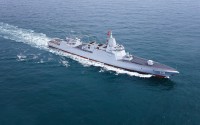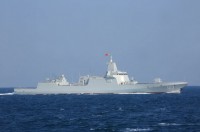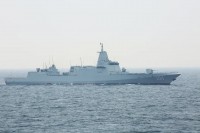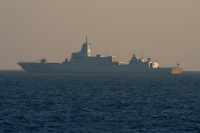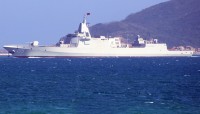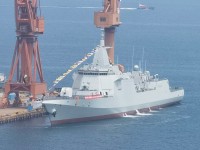Renhai-class destroyer (Type 055)
Basic information
Ship measurements
Machine
- 4 * QC-280 gas turbines (28 MW (38,000 hp) each), 112 MW (150,000 shp)
- 6 * QD-50 turbine generators (5 MW (6,700 hp) each), 30 MW (40,000 shp)
Personnel
Combat assets
- Type 346B (C/S-band) radar
- X-band radar
- Electronic warfare system
- 1 * H/PJ-38 130 mm gun
- 1 * H/PJ-11 CIWS
- 1 * HQ-10 short-range SAM 24-cell launcher
- 112 VLS
- HHQ-9 surface-to-air missiles
- YJ-18 anti-ship missiles
- YJ-21 anti-ship missiles
- CJ-10 land-attack missiles
- 2 * sets of 324mm torpedo tubes
- Yu-7 torpedoes
- 1 * Harbin Z-9
- 1 * Changhe Z-18
The Renhai-class destroyer is a class of stealth guided missile destroyers being constructed for the Chinese People's Liberation Army Navy Surface Force. It is a multi-mission design; the combination of sensors and weapons suggests a main role of area air defence, with anti-submarine warfare capabilities surpassing previous Chinese surface combatants.
The Renhai-class destroyer is expected to undertake expeditionary missions and form the primary escort for Chinese aircraft carriers. The United States classifies these ships as cruisers. The United States Navy defines a cruiser as a large multi-mission surface combatant with flag facilities; this suggests the U.S. expects the Type 055 to fulfill a similar role as the Ticonderoga-class cruiser.
The People's Liberation Army Navy was interested in a large destroyer from at least the late-1960s. A development program, code-named «055», initiated in 1976 was cancelled in 1983 after encountering insurmountable technical obstacles from industrial underdevelopment; for example, the required gas turbine power plants could neither be produced domestically, nor imported at acceptable prices.
In April 2014, an image emerged of a full-scale mock-up of the Type 055 superstructure — with enclosed integrated mast for radar and other electronics — at the Chinese naval electronic testing range in Wuhan.
Nanchang, the first ship of the class, began construction in 2014 at the Jiangnan Shipyard in Shanghai, and was commissioned on 12 January 2020. Its first public appearance — preceding commissioning — was during the PLAN's 70th anniversary parade on 23 April 2019. When launched, Nanchang was among the largest post-Second World War warships launched in East Asia.
The Renhai-class destroyer adopts a conventional flared hull with distinctive stealthy features including an enclosed bulbous bow that hides mooring points, anchor chains and other equipment. The bow and main deckhouse are configured similarly to previous Type 052C/D destroyers. A continuous structure amidship increases internal volume and reduces radar cross-section. The smoke stack design reduces both infrared signature and radar cross-section. Chinese sources credit the design as being generally stealthy, with reduced radar, noise, infrared, and electromagnetic radiation signatures.
Propulsive power is generated by four 28 MW QC-280 gas turbines in combined gas and gas arrangement. Additional power may be provided by six 5 MW QD-50 gas turbines. The maximum speed is estimated to be 30 knots.
Chinese literature suggests that the Renhai-class destroyer is capable of «facilitat'' command management of a battlegroup and supporting elements». The command-and-control and battle management systems are likely comparable to contemporary PLAN systems, which reflect over a decade of intensive interest in information integration from the late 2000s.
Sensors include four S-band Type 346B active electronically scanned array (AESA) radars, X-band radar, a bow hull-mounted sonar, and a towed-array sonar.
Various electronic warfare support measures (ESM), electronic countermeasures (ECM), and electro-optic (EO) sensors and datalinks are mounted. They are likely more advanced than those deployed on previous ships.
A deployment port exists for variable depth and towed array sonar. The large bulbous bow likely contains a bow sonar; the Renhai-class destroyer may mount a larger bow sonar than previous Chinese surface combatants.
The primary armament are missiles carried in 112 universal vertical launch cells (VLS); 64 cells forward and 48 cells aft. The same VLS model is used on the Type 052D destroyer, which is believed to be an implementation of the GJB 5860-2006 standard. The longest variant, with 9-metre cells, is likely used. The Renhai-class destroyer is expected to carry HHQ-9 surface-to-air missiles, YJ-18 anti-ship cruise missiles, CJ-10 land-attack cruise missiles, and missile-launched anti-submarine torpedoes upon entering service. Potentially, the larger cells may also carry anti-ship ballistic missiles.
It has been suggested that future variants may be armed with lasers or electromagnetic railguns. Since the current design does not have integrated electric propulsion, installation of integrated electric propulsion will be required for the ship to meet power requirements in the future.
Ships8
- Comments
 en
en ru
ru uk
uk
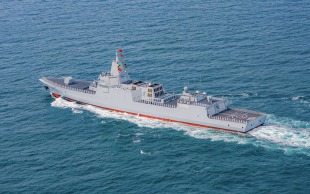
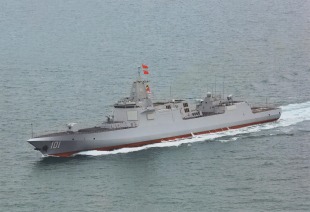


 People's Liberation Army Navy (Chinese Navy)
People's Liberation Army Navy (Chinese Navy) Dalian Shipbuilding Industry Company
Dalian Shipbuilding Industry Company